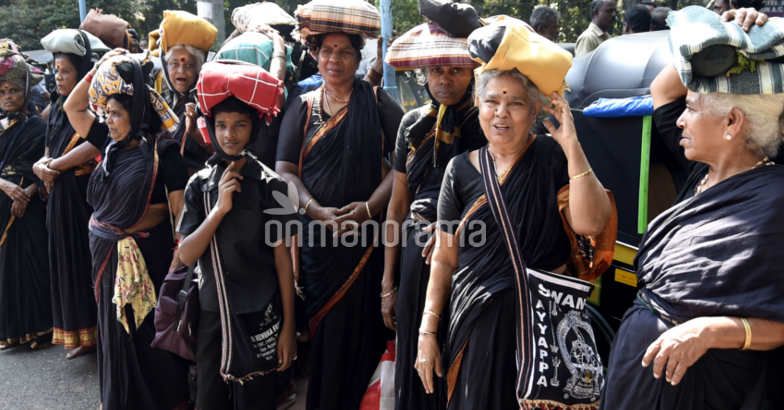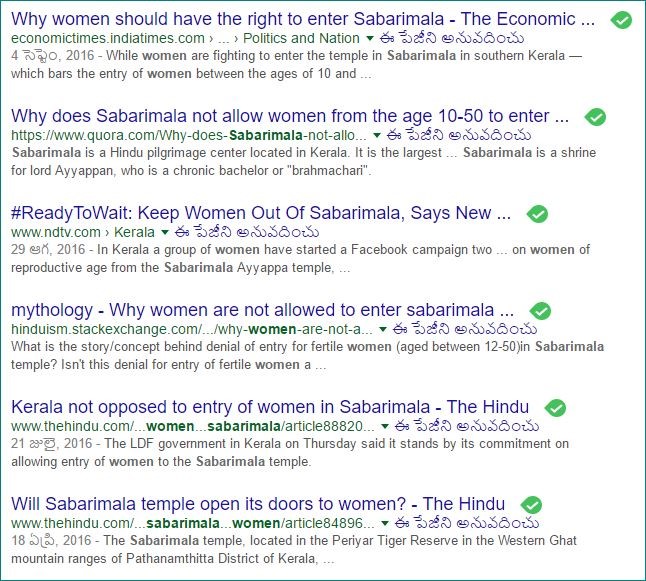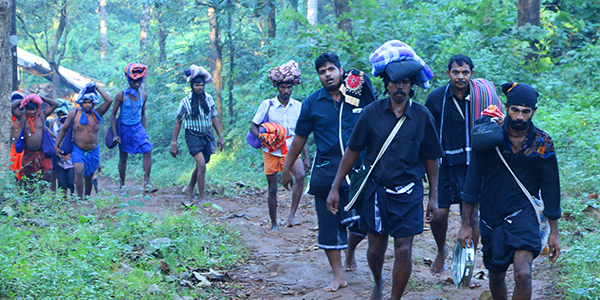I am neither for, nor against the ‘entry of women’ into Sabarimala devalayam. But I strictly oppose the frame work within which the issue is being debated, at least in the public domain.
Anyone who looks at the Sabarimala issue related to entry of women, in isolation, cannot understand the bigger and the real picture. It has to be looked at as an attack on Hindu Dharma and its traditions in tandem with several other bans, restrictions, Human/Women/Animal/Environmentalists fight against Hindu festivals/traditions like Jallikattu, Dahihandi, Holi, Deepavali, Ganesh Chaturdhi, Made Snana etc. The purpose is to restrict Hindus celebrating their festivals/traditions, disconnect Hindus from their tradition and there by facilitate religious conversions. Make no mistake; none of the groups fighting against Sabarimala Devasthanam has any love for women. The major problem that women in India suffer from is the alcoholism of husbands. But feminists, rather than fighting against this menace, support females who are becoming alcoholic, in the name of equality. Dharma proposes equality by advising men against alcoholism and feminists try to bring equality by making even females alcoholic. Feminists stand support businesses and Dharma supports human welfare. Fighting for women entry in Sabarimala ignoring alcoholism is like treating a patient for dandruff ignoring cancer.
What is ‘Sabarimala Issue’?
With this perspective, I shall go into the Sabarimala issue little deeper. The ‘Sabarimala issue’ is about restricting the entry of women with active menstruation cycle, let me tell you again, it is restricting women with active menstruation cycle and NOT women. But most of the feminists, TV Anchors, Main Stream Media cleverly present this as restriction on women and make this a case of gender discrimination, which this is not. You can call this discrimination against women with active menstruation, but please don’t call this discrimination against women as lakhs of women visit Sabarimala every year. See the below screen shot to understand how misleading the headlines of various main stream media are regarding ‘Sabarimala issue’

Source: https://english.manoramaonline.com/news/kerala/2017/10/14/tdb-chief-women-entry-sabarimala-thialand.html
False/pre-decided narratives on Sabarimala
Those who are fighting against the restriction in Sabarimala try to fit this in the below frameworks
- Discrimination of women in Sabarimala
- Discrimination of women in Hindu Temples
- Discrimination of women in Hinduism
- Discrimination of women in India
Men are not allowed into Attukal Devi temple in Kerala, also called as Sabarimala of Women1 – Neither this is discrimination against men nor Sabarimala a case of discrimination against women
There are lakhs of temples and only a handful has such restrictions – So there is no discrimination against women in Hindu temples.
Hinduism is the only religion in which the divine is worshipped in feminine form – So Hinduism doesn’t discriminate against women.
India is one of the safest places for women, as the respect for women is drummed into Indians from childhood. Anyone who lives in India with an open mind can see this everywhere and for those Westernised, elitist, feminists, statistics are available to prove this2.
Not just the restriction on women with active menstruation cycle, Sabarimala also have several other restrictions/specialities.
- Most of the devotees who visit the temple take up Ayyappa vratham/deeksha for 41 days before visiting. This deeksha is very popular in South India and most south Indian families will have at least one person who followed this.
- Brahmacharya, sleeping on floor, wearing black clothes, eka bhuktham, no hair cut, no alcohol/smoking/non-veg, no foot ware, cold water bath every day before sunrise and after sunset, devalayam visit twice a day etc., are some of the rules that those who take up Ayyappa Deeksha strictly follow
- Those without deeksha should not enter through the holy Pathinettampadi (18 Steps)
- There is no transportation till the devalayam and one must walk a minimum of 10 Kms. Those who do vanayatra walk 45+ KMs bare foot. Most of the route is hilly.
- Sabarimala is open approximately 90 days a year only, during winter and is being visited by approximately 4 crore devotees every year. Most of those who visit Sabarimala visit after Ayyappa deeksha.
- Women with active menstrual cycle are advised not to enter the temple
Aagama Sastra – Science behind Devalaya Nirmanam
Hindu devalayams are built based on Aagama Sastra, an ancient Bharatheeya science. Aagamas are classified into three types, namely Saivagama, Vaishnava Aagama and Sakta Aagama. There are 100s of Agamas and most of them fall into one of these three. Every Hindu temple is supposed to be built as per one or the other Aagama. There are specifications mentioned starting from selecting the land to selecting the stone (Pum-sila is used for the moorty of Purusha Devatha, Stree-sila for the moorthy of Stree Devata and Napumsaka-Sila for the rest), Pranaprathista of the devatha moorthy, Naivedyam, Devalaya Pooja, Alankarana of the Moorthy etc. Everything about a devalayam is based on Aagama Sastra, including the restrictions on women with active menstrual cycle in Sabarimala.
Ayyappa in Sabarimala is a Nitya Brahmachari and the prathista of Ayyappa is a Brahmachari Pratista (Pranaprathista of the Moorthy). As per Agama Sastra women with active menstruation cycle should not visit a temple with such a pranaprathista. The same agama that says about the presence of divinity in temple also talks about various restrictions. One that believes in divinity in devalayam should also respect restrictions. Those who don’t have respect for restrictions effectively means that they don’t have respect for either agama sastra or devalaya vyavastha. It is hypocrisy to say that I believe in divinity in a devalayam but don’t care about the restrictions. Is it not stupidity to say that “I believe in medical science but don’t care about the food restrictions the doctor suggest”? Having said that, I don’t advocate being frozen in time. The strength of Hindu Dharma is that it has been changing with time and it should continue. But the changes should be discussed and made within the framework of dharma and not Western Feminism or Western Liberalism or Western Modernity or some other Western imposition. So, it’s the pundits of Aagama Sastra who should debate and decide whether or not certain restrictions can be relaxed. Whether it is Sabarimala or Sanisingnapur or anything else, it’s the Agama Sastra Pundits that should take a call and not a novice feminist or a TV anchor who don’t even know the basics about devalayam. Who will take a call about the restrictions in a nuclear reactor, a nuclear scientist or a TV anchor? The same logic applies to devalaya vyavastha as well.
Different Devalayams – Different Rules
There are several temples with different restrictions as per the agama Sastra. For example every one can enter the garbha gudi, without even taking bath, of Srisailam, touch the Siva lingam and do abhishekham but in Srikalahasthi, another Sivalayam, no one is allowed even near the garbha gudi. Different kinds of pranaprathista, different rules.
Aagama Sastra doesn’t sound scientific or logical to these so called activists. So does devalaya vyavasta and so does Ishwara. The logic/rationality that is being used do mock at the restrictions in Sabarimala can be used even to mock devalaya vyavasta and even the very existence of Ishwara. If ‘modern science’ is the framework of debate, forget about restrictions, the concept of Ishwara itself don’t stand modern science. Then why not destroy all the temples and use the empty land and wealth for hospitals, schools, wine shops, cinema halls, shopping malls, slaughter houses etc. Neither the restriction of the entry of women with active menstruation cycle into Sabarimala Devalayam nor the concept of Bhagavan/Ishwara don’t stand the science we now know. Modern science is yet to evolve to a stage where it can understand these things.
People who call this tradition of Sabarimala as discriminating are either ignorant or are doing this with an objective to harness victimhood in Hindu women. Sabarimala is a typical case where the facts are twisted to manufacture atrocity literature3 to suit the pre-decided agenda to destroy Hindu culture and traditions to facilitate conversions.
Advocate Naushad Ahmed Khan is the president of the Indian Young Lawyers Association which filed the PIL in the Supreme Court seeking for the lifting of restriction in Sabarimala. It would be interesting to know his views on Triple Talaq, Burqa and other discriminatory practices of Islam against women. What is the interest of Sri Naushad, a Muslim, in Sabarimala, a Hindu temple, is anybody’s guess.
References
- http://www.attukaldevi.com/pl/attukal-pongala-festival.htm
- http://www.organiser.org/Encyc/2013/2/23/Is-India-a-nation-of-rapists-and-killers-.aspx?NB=&lang=4&m1=&m2=&p1=&p2=&p3=&p4=&PageType=N
- https://indiafacts.org/atrocity-literature-western-recipe-dismantle-india-hinduism/
Featured Image: Daily Hunt



